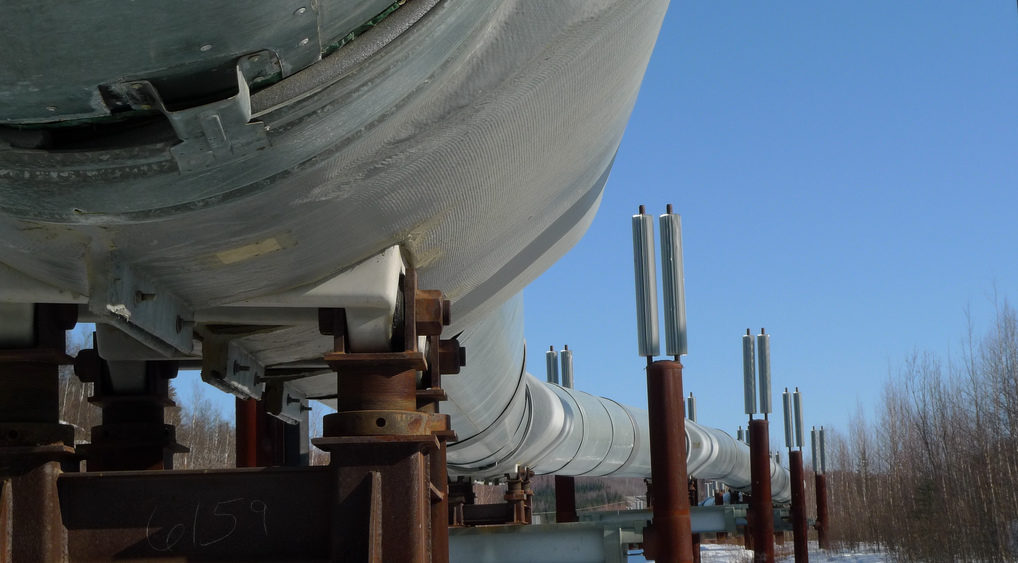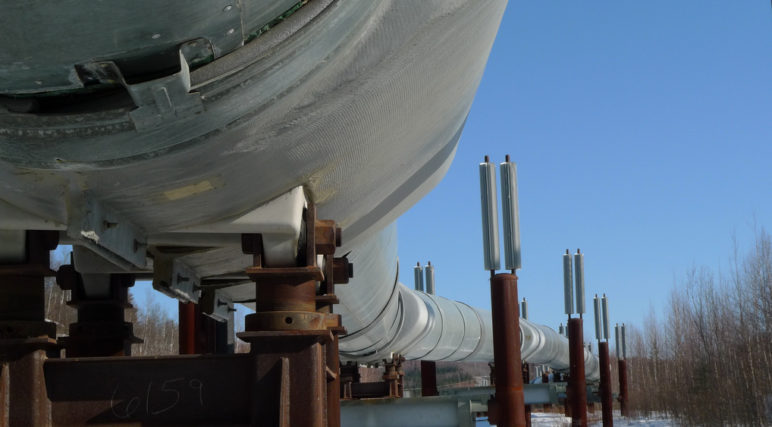There’s much ado about expansion plans for Canada’s Trans Mountain Pipeline, and with good reason: exporting tar sands oil through the Salish Sea poses huge spill risks to the region. Now there’s reason to think that Washington may see a giant pipeline expansion of its own.
Kinder Morgan may also be planning to more double the size of the Puget Sound Pipeline, boosting its capacity from 240,000 to 500,000 barrels per day.
Kinder Morgan, an energy goliath with a checkered past, owns the Trans Mountain as well as the connected Puget Sound Pipeline, which runs through Whatcom and Skagit Counties in northwestern Washington State. The company is planning to begin construction this year on a near-tripling of its Canadian Trans Mountain Pipeline’s capacity—adding a new 590,000-barrel pipe alongside the existing pipe. The resulting “twinned” line would be bigger than the planned Keystone XL Pipeline. And south of the border, new financial disclosures indicate that Kinder Morgan may also be planning to more than double the size of the Puget Sound Pipeline, boosting its capacity from 240,000 to 500,000 barrels per day.
The existing Trans Mountain line delivers 300,000 barrels of crude oil daily over a 715-mile route from Alberta to the Northwest. Some of it goes to a marine terminal at Burnaby, British Columbia, where it is loaded on vessels for export to Tacoma, Washington, several locations in California, and other refining centers. Yet most of the oil, about 191,000 barrels daily, is diverted to a branch line known as the Puget Sound Pipeline, which delivers the fuel along a 69-mile route to four refineries at Ferndale and Anacortes, Washington.

Original Sightline Institute graphic, available under our free use policy.
In operation since 1956, the 16- to 20-inch pipeline that comprises the Puget Sound system has four breakout tanks, designed to store oil for later pipeline shipments. The Puget Sound Pipeline accounts for roughly a quarter of all the crude oil delivered to Washington, requiring approximately one day for the crude to reach its destination. The company has reported only five spills to state and federal authorities over the course of the pipeline’s lifespan and none in the past 17 years.
In 2012 and 2013, company officials hinted at possible expansion plans to the Puget Sound line—either in addition to the Trans Mountain enlargement or as an alternative to it if the BC route proved unworkable—but those ambitions seemed to have fallen by the wayside. After a 2013 expansion from roughly 180,000 to 240,000 barrels per day, Kinder Morgan appeared content to focus on growing Trans Mountain. In the meantime, the Puget Sound system continued to fill with Canadian oil, “with 2015 and 2016 experiencing increases from previous years of over 15 percent and 30 percent, respectively,” according to the company.
Yet new information contained in Kinder Morgan’s financial disclosures shows that the firm may be intending to more than double the Puget Sound Pipeline’s capacity. Looking to raise money to finance construction on the Trans Mountain expansion, the company’s Canadian subsidiary has filed for an Initial Public Offering. In at least five places in the marketing materials and prospectus documents, Kinder Morgan asserts that the Puget Sound Pipeline “is capable of being expanded to increase its capacity” to 500,000 barrels per day.

Original Sightline Institute graphic, available under our free use policy.
The company is pitching the expansion possibility to potential investors, presumably because expanding the Puget Sound line in coordination with Trans Mountain would enable the company to deliver more fuel to some of its prime destinations in the Northwest. And according to statements in the IPO filings, the expansion might also free up Alaska oil for export to foreign markets after the Obama Administration lifted the longstanding ban on exporting American crude oil. In other words, a Puget Sound expansion could indirectly act as a way for US oil producers to sell more oil abroad.
The state would likely be confronted with new challenges to protect local communities and sensitive ecologies from the risks of notoriously harmful tar sands spill.
Although Trans Mountain provides the sole pipeline link from Alberta’s oil sands fields to the Northwest, the existing line handles a variety of oil types. Historically, it has not been dominated by tar sands oil, which would comprise the bulk of the shipments in the planned Trans Mountain expansion. In 2012, for example, Kinder Morgan reported that the pipeline was carrying 45 percent light crude, 22 percent heavy crude (which could refer to an oil sands product), 16 percent synthetic crude (which could be a blended product containing oil sands), and 16 percent refined product (such as diesel or gasoline). But in the years since, oil extraction in Alberta’s tar sands region has boomed, and the planned Trans Mountain expansion is designed explicitly to deliver huge quantities of the sticky, heavy oil to export markets.
It’s reasonable to assume, therefore, that a twice-as-big Puget Sound line would likely carry large volumes of tar sands oil through northwest Washington, too. From its destination points at Whatcom and Skagit County refineries it would either be processed into useable consumer fuels or possibly loaded onto tankers for export. In either scenario, the state would likely be confronted with new challenges to protect local communities and sensitive ecologies from the risks of notoriously harmful tar sands spills.
Update 6/1/18: In its SEC filing for 2017 Kinder Morgan says that it could expand the Trans Mountain even more than currently planned, and the company reiterates its interest in doubling the Puget Sound line:
While we do not presently have any plans to expand TMPL outside of the current scope of TMEP, the combined capacity of the expanded pipeline could potentially be further increased by over 300,000 bpd to approximately 1.2 million bpd, with additional power and further capital enhancements. The Puget Sound pipeline is capable of being expanded to increase its capacity to approximately 500,000 bpd from its current capacity of 240,000 bpd. We will continue to monitor market and industry developments to determine which, if any, further expansion projects on TMPL may be appropriate.
This article benefited from research contributed by Alyse Nelson, John Abbotts, Carl Weimer, Matt Krogh, and Alex Ramel, and from editorial review by Tarika Powell.











Blair
It would seem that the expansion would be considered a win for the Pacific Northwest. Your story makes a pretty serious mistake about the Alaskan oil, which is running out and thus will not be available for export. The upgraded Trans-Mountain, therefore, would be replacing tankers or oil-by-rail to supply the Washington State refineries. Given a choice between oil-by-rail and pipeline, I’m sure you would prefer pipelines would you not?
Eric de Place
Blair, I’m honestly not sure what you’re talking about.
The only reference in my article to Alaska is a claim drawn from Kinder Morgan’s IPO materials: the company apparently thinks (speculates? wishes?) that ANS oil may move to foreign markets freeing up more room for Trans Mountain oil to Puget Sound.
There’s no discussion here of oil by rail.
Blair
The Puget Sound has refineries which require raw material to operate. Historically those refineries were supplied by two sources: via the Trans-Mountain and via Alaskan tankers bringing in North Slope oil. The North Slope supply is almost gone which leaves a huge hole in the supply network for the Puget refineries. As such the refineries need a new source of raw materials. Absent increased supply via the upgraded Trans Mountain the alternative is the overland (oil-by-rail) route. As you are likely aware, the Bakken crude (supplied by rail) is too light for most of the refinery capacity in the Sound so that oil-by-rail will be supplemented by imports of heavier crudes by sea to tune the inputs for the refineries. So to summarize, either you add more capacity via Trans Mountain or you get a massive ramping up of oil-by-rail accompanied by a continued (but lesser) flow of crude by via tankers. My argument is that the Trans Mountain is a safer means of transport than the oil-by-rail alternative.
Eric de Place
Couple of quick responses. First, I don’t think it’s accurate to characterize North Slope oil as “almost gone.” Admittedly, it’s far down from its production peak in the late 1980s, but it’s still steadily cranking out 500k barrels per day. Puget Sound’s share of that combined with crude delivered via pipe from Kinder Morgan (which has already expanded from roughly 180k to 240k) is probably enough all by itself even before you factor in 150k bpd from rail. After all, all five Puget Sound Refineries combined use less than 600k. Ramping up rail + more pipe simultaneously is probably overbuilding, and presumably it’s part of a larger strategy to export US crude.
But leaving all that aside, what I’d like to see is a decline in oil production and consumption. The world — even the West Coast — is awash in relatively cheap oil. We don’t have a supply deficit problem; rather we have an over consumption problem.
Blair
As the EIA points out in a continued low oil price environment the North Slope oil production essentially is gone by 2025 with TAPS closing in 2026 which gives very little time to find an alternative.
As for the Kinder Morgan to Puget Sound, it has not actually expanded yet, but was never used at its actual design capacity and only needed additional pumping stations to allow it to operate at design capacity.
As for the rest, in an ideal scenario no oil would move by rail but absent an alternative the refineries need feedstock.
As for reducing our demands that is the goal but I do not see the US making significant gains in that direction simply not increasing supply in the Western US would be a good start and as it stands the region needs all those refineries to remain online.
Phil B.
Blair, humanity badly needs a just transition to renewables, not a massive expansion of hard-to-reach damaging fossil fuels. This is no longer under debate.
Mike
Eric, you may or may not be aware, but using the word “tar sands” is a quick way to workers in the oil feilds backs up. It quickly closes conversation as its always been a word used to attack the industry, by mis-informing. Keep the conversation open, use the correct terminology.
Courtney
May I ask your source? I do not see any supporting evidence that Kinder has announced such expansion? Kinder has not put this info on their website and I would like to confirm, please?
Eric de Place
That’s exactly the point: they have not announced an expansion publicly nor have they applied for permits. What they are doing, however, is pitching it to investors. You can find all the evidence—at least five separate instances—in the Kinder Morgan Canada IPO documents that I linked to in the post: http://sedar.com/DisplayCompanyDocuments.do?lang=EN&issuerNo=00042650
It’s a serious issues that the company is selling prospective investors on a potential expansion to 500,000 barrels per day. That makes it real, in my view.
Derek
Hi Eric, thank you for your good work on this. Are there any new updates on this to-date?
Eric de Place
Thanks. Not to my knowledge, no. I suspect Kinder Morgan is hunkered down waiting to see what happens with the Canadian portion of the main line before moving on this.
HIDE BEHIND
Commentor mentioned “boon to Wa.” But no specifics to as what they were or to whom the boons will benefit.
Tar sand derived oil is very dirty, so dirty is it that Canadian westcoastdoes not want it, “let the americans breath to dirty air and find places for the waste products disposal”; and as the Puget Sound Waters, not just in SEA/TAC area but the whole FN body of water is so polluted it matters not what is dumped within it.
Pipeline jobs are almost always filled by transitory workers and once job completed they move on, leaving municipalitys with social programs and school funding bills and no new funding means to pay back the municipal nonds our bureaucrats and elected enjoy the majotity of privelege from.
Firm already own vast set asides as right-a-way so no noon to resident realestate sales and of course the State and Fed lands vost them nothing to disturb.
Washington State and Columbia River and its estuary systems are already polluted by chemical and radiological and humanitys trash.
Automated transfer stations and refinery,Anacotes runs about 60% of capacity so maybe increase work force 20 people on low end wages.
Bring it on the Canadian Billionaire who has arrest warrants on him from African nations will pay the Queen her Royalty checks, Canada only recieves mere 20% of Royalty while Billions will head for Caymen and Bahama banks.
Gus
Is there anymore information about the oil pipeline expansion in Canada?
Mike
Just go to Calgaryherald.com. the pipeline has turned into a bit of a Canadian circus.
georges bruneau
see
my post today on the CDN ministers meeting.
Ken
Nuts
Mike
Eric, the use of the term tar sands is a word that shows bias and and shuts down conversation, as it generally is used to attack the industry through misinformation. The term is oil sands, lets keep the conversation open and accurate.
georges bruneau
The latest news on KM pipeline through BC CND. today is that there is no news from the meeting of all provinces ministers and the Feds.
The Alberta minister said it is losing 80 millions per day. New Brunswick wants oil to replace expensive Saudi oil through a new pipeline from AB. Yet, no decision cause PQ is against it and the Feds hates oil. The only solution is for KM to work behind the red tape and build a line from Edmonton to WA.